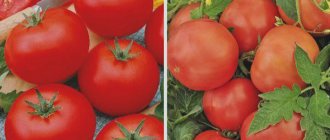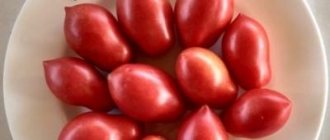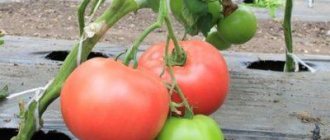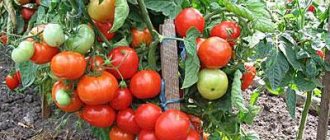This hybrid, bred by Chelyabinsk breeders, got its name completely justified: Robinson is one of the few who successfully survived the battle with the forces of nature.
| Height | Landing location | Ripening time | Fruit color | Fruit size | Origin | Fruit shape |
| Medium height | Greenhouse, Open ground | Early ripening | Pink | Large | Hybrid | Flat-round |
Unusual Robinson
Often the description of a variety promises mountains of fruit. But getting them is difficult. People are looking for a tomato that is undemanding to external factors.
Chelyabinsk breeders have created an interesting hybrid. Gardeners in the Urals plant it in open ground. The tomatoes have time to ripen and produce a rich harvest. Features of the Robinson hybrid:
- ripens very early (from germination to harvesting tomatoes 90 days);
- limited in height (< 1.20 m);
- the leaf blades resemble potato ones;
- To obtain the desired number of fruits, the formation of a bush is necessary.
Some gardeners grow Robinson in a greenhouse. One or three bushes are enough to provide your family with delicious tomatoes.
Ural summer residents actively occupy free beds with Robinson tomatoes: the plant requires a minimum of care, and the fruits delight with color and taste. In 2021, Gardens of Russia declared the hybrid a bestseller.
Features of growing early varieties of tomatoes in open ground
Experienced gardeners have long noticed some “tricks” that will help grow strong and healthy tomato plants in open ground:
- Early varieties for open ground require mandatory hardening of swollen seeds and seedlings. Such procedures will allow not only to plant plants in the beds ahead of schedule, but also to strengthen their immunity to sudden temperature changes.
- Even the earliest varieties of tomatoes experience stress when planted in regular beds. In order for the adaptation of a young plant to be as painless as possible, it is recommended to plant it in open beds only in the evening, when the air temperature drops.
- The first fruit cluster in early varieties of tomatoes is formed between the 7th and 8th leaves. After its formation, the buds sleeping in the axils of the lower leaves wake up. It is from these that the lateral shoots are subsequently formed. For this reason, saving the first cluster is a prerequisite for obtaining a large harvest. Under no circumstances should it be deleted. To prevent the flower cluster from falling off under the influence of low temperatures in open ground, it is recommended to use any growth stimulants. They need to be sprayed on tomato plants before the first fruit cluster forms.
What attracted summer residents
It is difficult to grow a tasty tomato in areas with unstable climates. The plant reacts to decreased sunlight and heat. Excess rainfall destroys the entire crop.
Berry characteristics:
- heavy tomato (weight 200-300 g);
- the berries of the first harvest are larger than subsequent ones;
- bright crimson color of ripe fruits;
- dense, not rough skin;
- characteristic small specks of dark crimson color;
- juicy, grainy pulp;
- weak ribbing at the stalk;
- round shape, slightly flattened;
- easy removal of ripe tomatoes from the bush;
- bright sweet taste;
- The seeds are small and cannot be felt when eating.
Robinson F1 is one of the rated tomatoes for growing in problem regions. Ripe tomatoes taste better than those grown in a greenhouse. Resistance to adverse conditions, planting in open ground attract gardeners.
See also
Characteristics and description of the Red Guard tomato variety, its yieldRead
Small ripe fruits of the second harvest look great in assorted vegetables. The juice and paste are sweet. The color of the blanks is unusual. The pulp does not spread during cooking.
Outline of the hybrid Robinson F1
The purpose of Robinson F1 is to provide productivity in the most unstable climate. The hybrid is early ripening, whose fruits reach technical maturity 85-100 days from the beginning of the appearance of the first shoots. Robinson is a representative of determinants, has a complete growth trend and reaches a height of 125 cm.
The plant is highly leafy and has large potato-shaped leaves. Its fruits are distinguished by a rich raspberry color and a flattened-round configuration of the fruits, reaching a weight of 200-350 g. The tomato skin is quite dense with a small light speckle, under which there is a juicy sugar pulp. The hybrid has increased resistance to damage by many pathogens, showing a yield of 3.5-5 kg per bush.
Secrets of growing Robinson
To get sweet raspberry fruits in open beds you will have to try hard. The advice of agronomists should be strictly followed:
- sow seedlings in the third ten days of February;
- fill the soil with fertilizers for seedlings (ready-made seedlings do not need this);
- loops have appeared - place on a bright, cool windowsill;
- picking into separate pots is required;
- Robinson needs to be fed and hardened;
- plant after return frosts;
- mulch the ridges;
- Cover the top of the planting with non-woven white material (protection from sunburn in the first days);
- bush height 1 m 20 cm: garter required;
- form a hybrid of 2-3 stems;
- heavy brushes: a garter is required;
- In case of prolonged precipitation, cover the ridges with film (protection from waterlogging).
Gardeners know: excess nitrogen causes tomatoes to fatten. Balanced mixtures of potassium and phosphorus strengthen the plant and accelerate fruit ripening.
Robinson manages to deliver the harvest before the August cold snap. It “escapes” late blight. But garden pests fell in love with the juicy, sweet fruits. It is necessary to carry out preventive measures: collect snails, treat plantings with insecticides.
General information about determinate varieties
These tomatoes are characterized by limited growth and low bushes. Their leaves and inflorescences are densely located on the stem. There are 3 groups of this kind of tomatoes:
- determinant - characterized by a double wave of growth. At the first fruit setting, there are up to 6 inflorescences, then so-called stepsons grow on the shoots, on which other inflorescences are formed, giving a second harvest. These tomatoes are characterized by early ripening. In this case, fruiting lasts 1-2 months;
- superdeterminate - characterized by early ripening. They have a bushy plant, the height of which reaches 0.7-1 m. As a rule, after the formation of 2-3 inflorescences on the shoot, growth stops. These varieties are characterized by uniform ripening of fruits. Such tomatoes are often planted over large areas when the entire crop needs to be harvested in a short time;
- semi-determinant - represent the average of the two previous groups. The height of the bushes reaches 1.2 m. They are characterized by later ripening. These tomatoes, the cultivation of which does not require pinching (removal of second-order shoots), will bear fruit earlier if they are removed from the bushes.
Determinate and indeterminate varieties do not take stepson.
General information about such varieties
Indeterminate tomatoes are tall plants. This means that to grow them you must use trellises or other supports to which the bushes are tied. To answer the question of what indeterminate tomatoes are, you first need to determine the morphological characteristics of these plants. On such bushes, inflorescences form after 6-10 leaves. Such tomatoes belong to late-ripening varieties that can bear fruit almost until frost. As a rule, the largest yields are harvested from bushes in which 1-2 main stems were left by pinching at the beginning of growth.
Tomato varieties
Descriptions of tomato varieties will help when choosing seeds for planting. So, recently the following indeterminate varieties have become especially popular.
- Astona F1 – intended for cultivation in closed and open ground. Vigorous, powerful plant. It has high productivity. The fruits are flat-round, red. Their average weight is 170-190 g. The fruits are resistant to cracking. The plant forms ovaries well and is disease resistant.
- Kronos F1 is a wonderful early variety for growing indoors and outdoors. It has high productivity. The first brush is already located above the 6th sheet. Red flat-round fruits weighing 140-170 g are distinguished by good transportability and keeping quality (1-1.5 months). The variety is resistant to most diseases.
- Shannon F1 is an early maturing hybrid with moderate plant growth vigor. This variety is intended for cultivation in greenhouses and open ground. Tomato is resistant to most diseases. It gives excellent results with early plantings. This variety bears fruit well, even if the air temperature is several degrees lower than necessary for growing other tomatoes. Red, round fruits weighing up to 180 g are distinguished by excellent taste. Stored for up to 1 month.
- Sprinter F1 - tomato designed for growing indoors. The plant is very powerful and high-yielding. Resistant to most diseases. This variety is distinguished by its early entry into the fruiting phase. Up to 4 clusters ripen on the plant at the same time. Flat-round fruits weighing 150-190 g are red in color.
Tomato varieties (description of tomato varieties) are often indicated on the seed packaging. That is why when purchasing you need to be very careful to choose the right tomatoes. Other popular indeterminate varieties include such hybrids (indicated by the letter F1) as Axioma, Title, Saxon, Sheila, Vitador, Menhir, Samara, Typhoon, Pisa, Flagman, Etude, Intense One, Sreza, Favorite, Jakarta, Castalia.
Preparing seedlings for planting
After picking, the seedlings are transferred to a room whose temperature does not exceed +20˚C. 1-2 weeks before planting in open ground, plants begin to harden, gradually reducing the air temperature. Seedlings can be planted until the first brush appears on it. To strengthen the plants, it is recommended to water them with water with the addition of special complex fertilizers. They are diluted in a ratio of 20 g per 10 liters.
The seedlings are planted in prepared holes, burying the plant in the soil up to the cotyledon leaves. Seedlings that are too elongated can be planted even deeper (up to the first true leaf), placing them in the hole in an inclined position.
Recommendations for growing tomatoes
- Seeds are sown in late February.
- Before planting seeds, the soil is disinfected and fertilizers are applied.
- When planting a tomato in open ground, do not forget to harden it two weeks in advance.
- It is worth remembering that seedlings are watered only with warm water.
- Lack of fertilizer affects the leaves and stems of the plant.
- An excess of fertilizing can be detrimental to a tomato. Apply fertilizers according to the instructions found on the packaging of complex fertilizers.
- Robinson tomato bushes are tall, so they will need support.
- To get a good return, the plant is formed into 2-3 stems.
- In August you will be harvesting.
- The main pests are snails. The chemical drug “Thunderstorm” will help against parasites.
Sowing seeds
If you trust the seed supplier, then no pre-sowing treatment is required, since licensed seeds are already specially prepared. In this case, their germination and seedling growth will depend on the choice of a suitable substrate and watering. It is best to choose soil that is specially prepared for growing seedlings. This substrate is sold in any specialized store.
Tomato seeds are planted in the soil to a depth of 1-1.5 cm. After the first true leaves appear, the seedlings dive. After this procedure, the root system of the plants becomes more fibrous, and the plants themselves are leveled in height. The optimal temperature for tomatoes is +24˚С. To grow in open ground, tomatoes are sown 30-40 days before planting in the ground.
Variety selection
All varieties of tomatoes, photos of which can be found in reference books, look very appetizing and tempting, but when choosing seeds for planting, you must take into account the growing method and region. If you plan to grow indeterminate tomatoes in a greenhouse, then you can choose almost any variety you like. For many regions of Russia, late-ripening plants are absolutely unsuitable. If the temperature is not high enough and the daylight hours are short, such tomatoes will not have time to ripen. That is why varieties of early or medium ripening are more suitable for the more northern regions of Russia. If you want to try late tomatoes, you will need to make a small shelter for the plants in the form of a greenhouse with additional lighting on autumn days.
It is also necessary to take into account that large fruits are not suitable for canning as a snack, since they simply will not fit into a jar. These tomatoes are intended for salads or for processing into juice, sauces or pastes. Fans of pickles should plant indeterminate varieties with small and medium-sized fruits.







